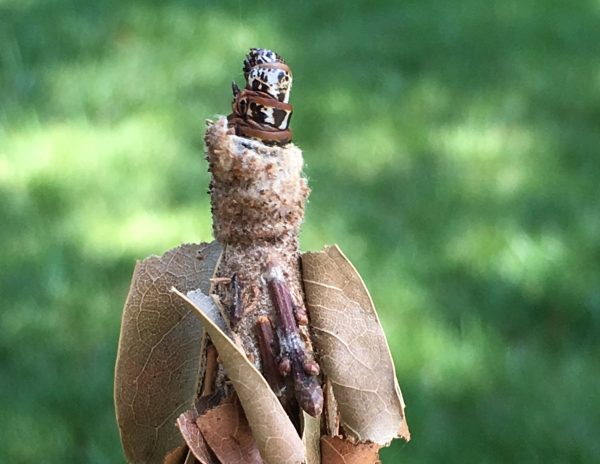Finding the beauty in a bagworm

I was on my regular walk one hot morning in late July. I was late and, in truth, I was in a hurry to get it over with.
Despite my task-oriented blinders, a bizarre motion caught my eye. In the front yard of a house across from Charlotte’s Latta Park, a clump of brown leaves was levitating a foot or so above the grass.
My brain sought the mundane explanation. Just the tip of a branch caught in a spider web strand. Then the clump began to gyrate and sway. A rational naturalist, I knew it was animated by the wind, but its movements seemed otherworldly. It’s a wee fairy, I thought, with awe and delight, my mind tumbling into a deep reservoir of memory filled with pagan Celtic blood. Jung might have called it the collective unconscious.
The overall cluster was about the size of my fist. A woven cylindrical core was decorated with willow oak leaves, some of them whole and others torn. They had been applied in an intriguingly symmetrical pattern, creating the effect of wings and a tail. Tiny twigs with swollen buds had also been incorporated into the design, their weight providing a ballast. The creature twirled and fluttered in the breeze, a sylvan ballerina.
Suddenly, a head popped from the top of the cylinder. Images from Alien and Stranger Things interrupted my reverie. The head was spotted brown and cream and appeared to writhe in agony. But this was not the stuff of nightmares or science fiction – just a caterpillar struggling to escape its fancy cocoon. Hanging by a long, invisible thread, it arced across the sidewalk. I wanted to protect it from unwary pedestrians. I settled in for the long haul, hoping to watch it fully emerge. As it wafted about on the breeze, I realized it was also inching higher, back toward the willow oak’s canopy.
It was ascending.
Twenty minutes later, it was almost ten feet off the ground. Still wriggling, it hadn’t made any further progress toward extricating itself. Since it was safe and I had other obligations, I finished my circuit and stopped by again on my way home. By then, it was a good fifteen off the ground, close to the oak’s lowest limbs. Some of the leaves on a nearby branch were ragged, as though they’d been chewed.
Back home, I emailed photos to knowledgeable friends. Impatient, I also tried iNaturalist, which instantly narrowed my search to a type of bagworm. At first, I thought the app had to be mistaken. I couldn’t imagine a more inelegant name for such an ethereal creature.
The eastern or common bagworm (Thyridopteryx ephemeraeformis) is also sometimes known as the evergreen bagworm due to its affinity for conifers. Their cocoons vary greatly in appearance, reflecting the materials the caterpillars collect from their particular host plant. The bags are enlarged as the larvae mature through seven instars. They carry the bags as they move about creating their masterpiece, a clunky but exquisite means of camouflage.
Far from celebrating the bagworm’s artistic achievements, most websites I visited in the course of my research focused on their eradication. A heavy infestation can damage ornamentals, especially evergreens such as arborvitae, junipers and Leyland cypress. The best intervention is to remove the bags before eggs hatch and larvae disperse in late spring, but if a tree’s health or aesthetic value isn’t at risk, consider leaving them in place. Not only are they a fascinating decoration, their inhabitants are a food source for sparrows, woodpeckers and other songbirds.
Many websites glossed over the gruesome details of their reproductive cycle. The female never develops wings. She never leaves her cocoon. In the adult stage, she lives about two weeks, emitting pheromones to attract the male. As a hairy, dark moth, he lasts only a couple days. They mate through the veil of her magnificent wrap. Afterward, she either dies and falls to the ground or “mummifies” around the fertilized eggs. That’s an image worthy of a horror film or a dystopian novel.
In the days after my encounter, I scanned the branches of that willow oak on my daily walks.
A cluster of brown leaves straddled a branch in the general vicinity, but it was too high for me to get a positive identification, even with binoculars. Maybe it was the same bagworm, hunkering down during her final stage of maturation. Bagworms mate in the waning days of summer. Based on that timing, I like to imagine I’d witnessed the wild dance of an exuberant teenager, exalting in her brief moment of self-expression and freedom.
